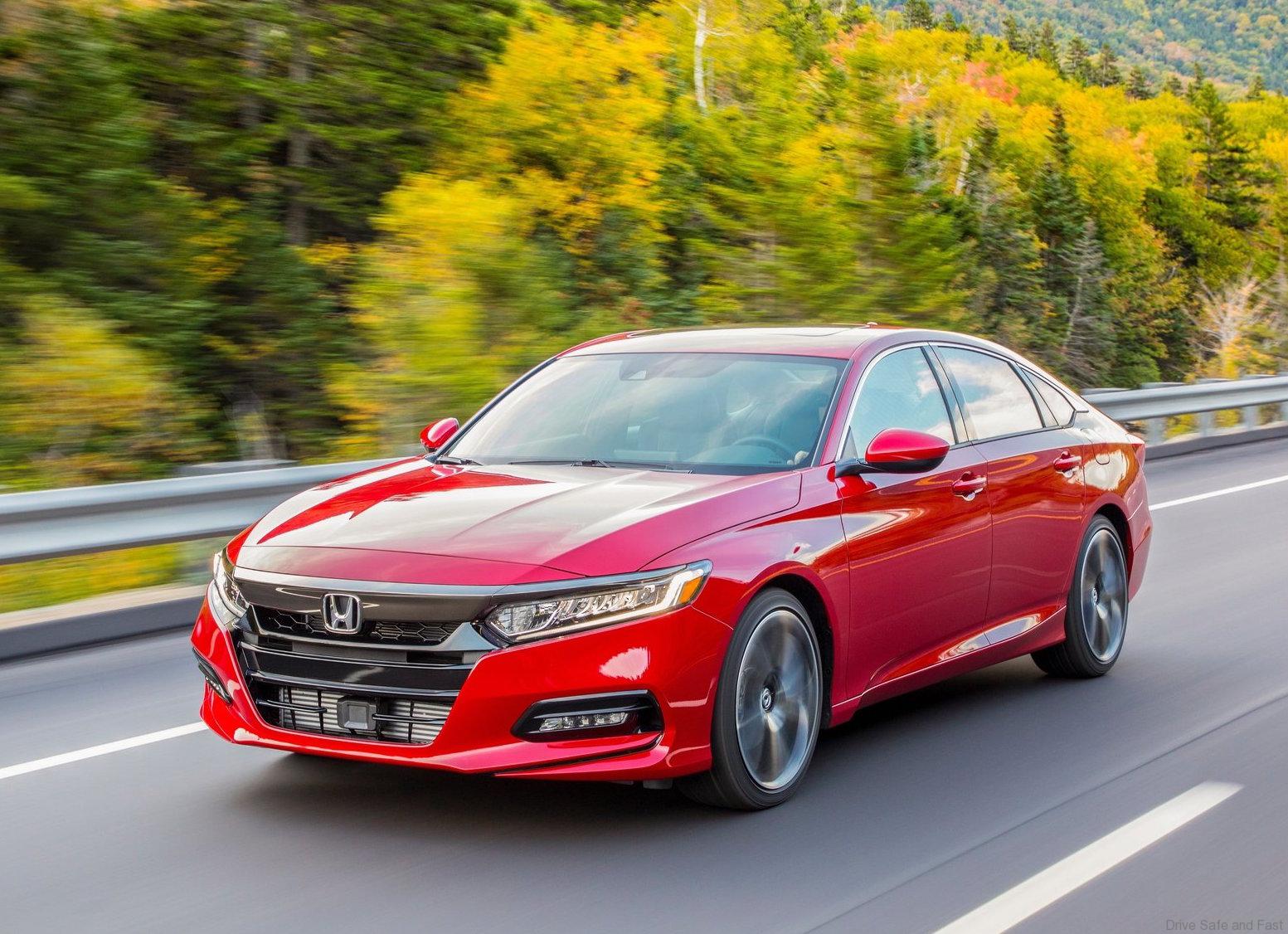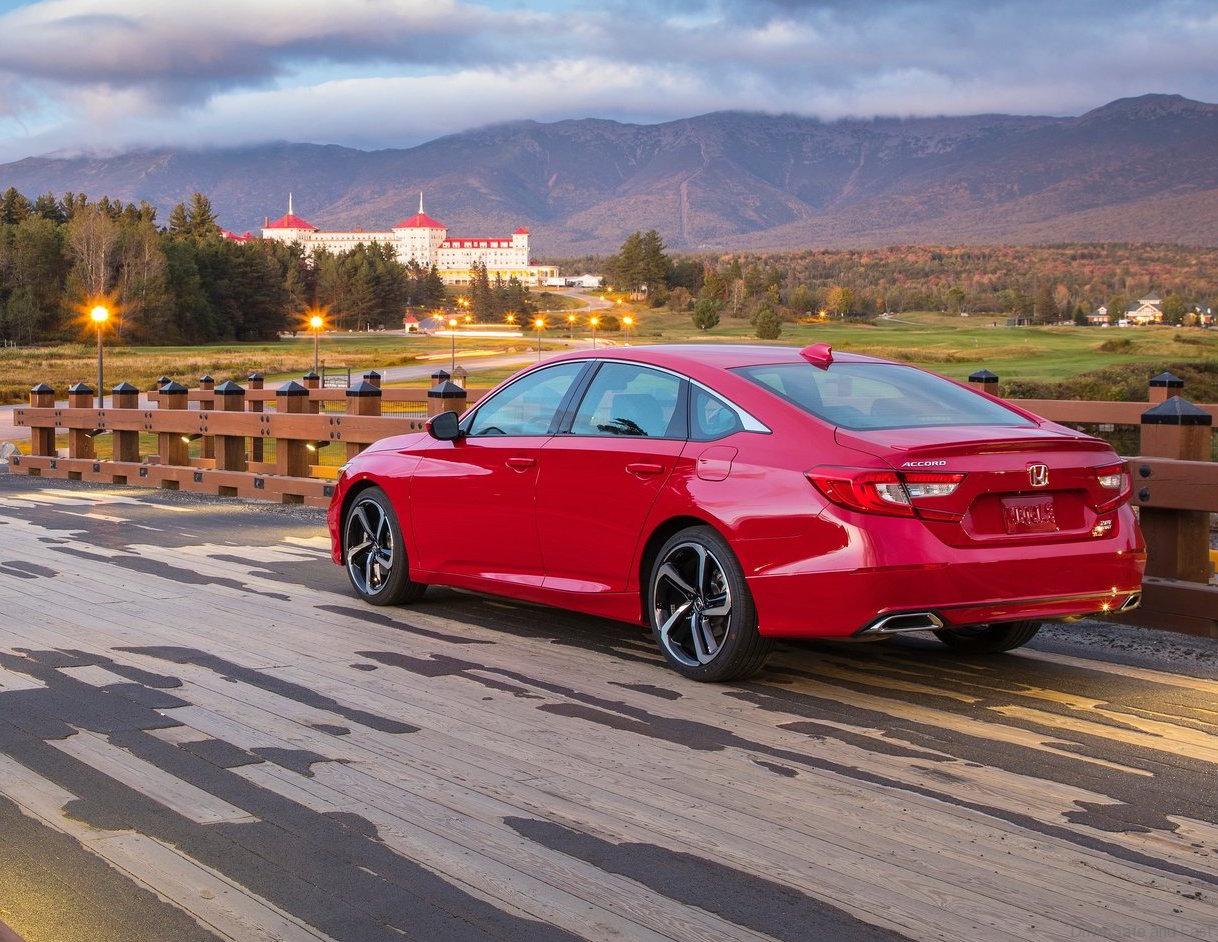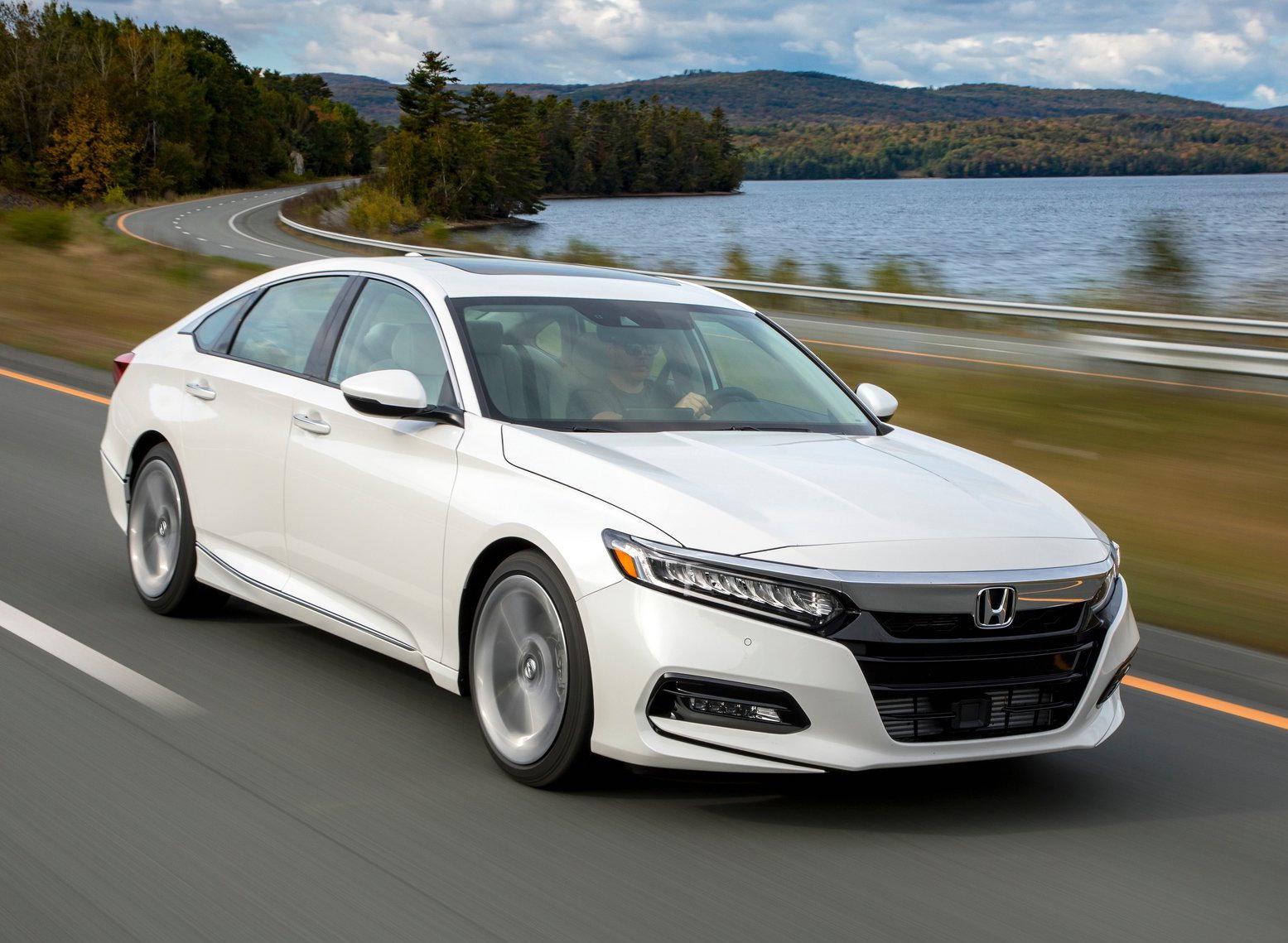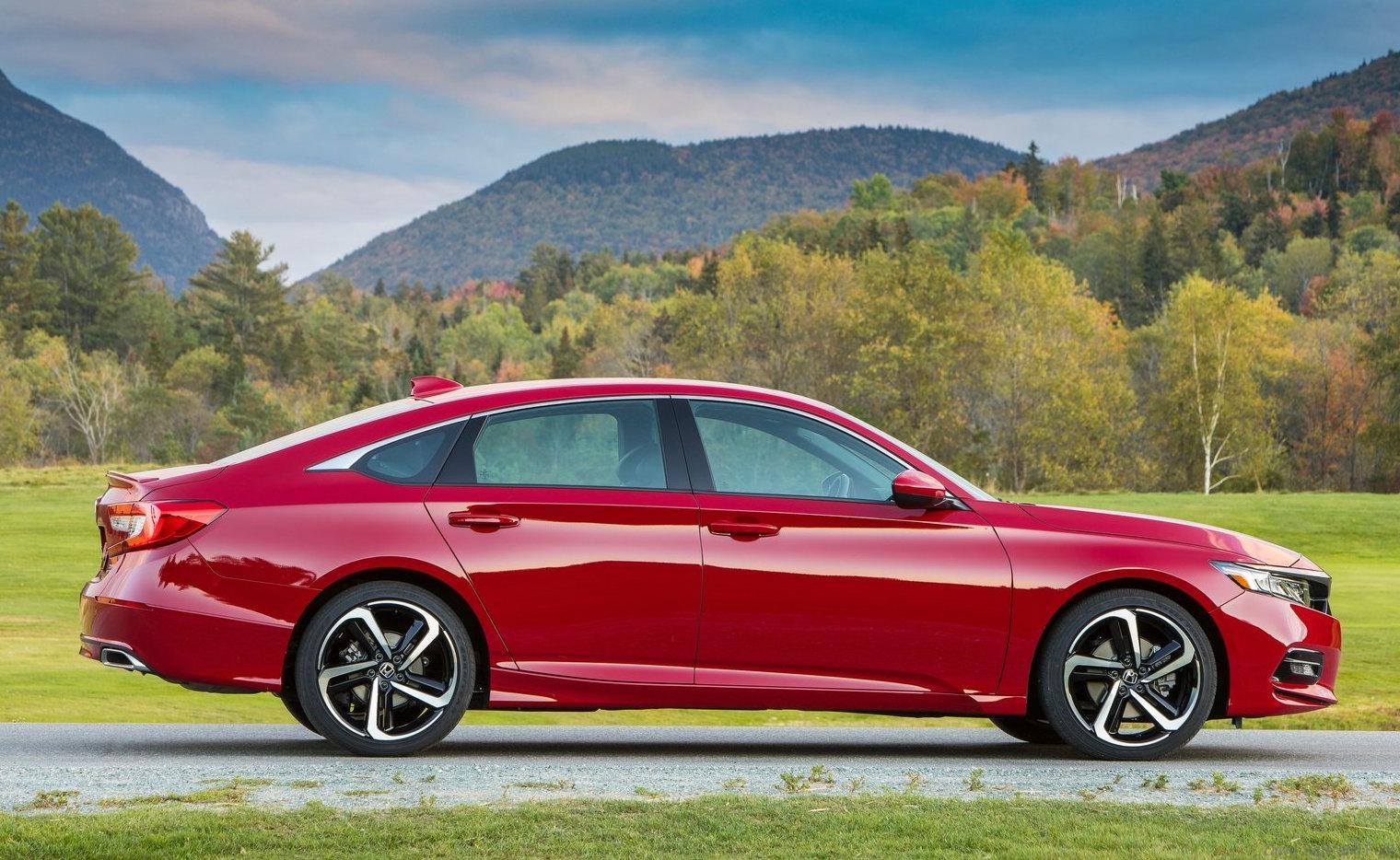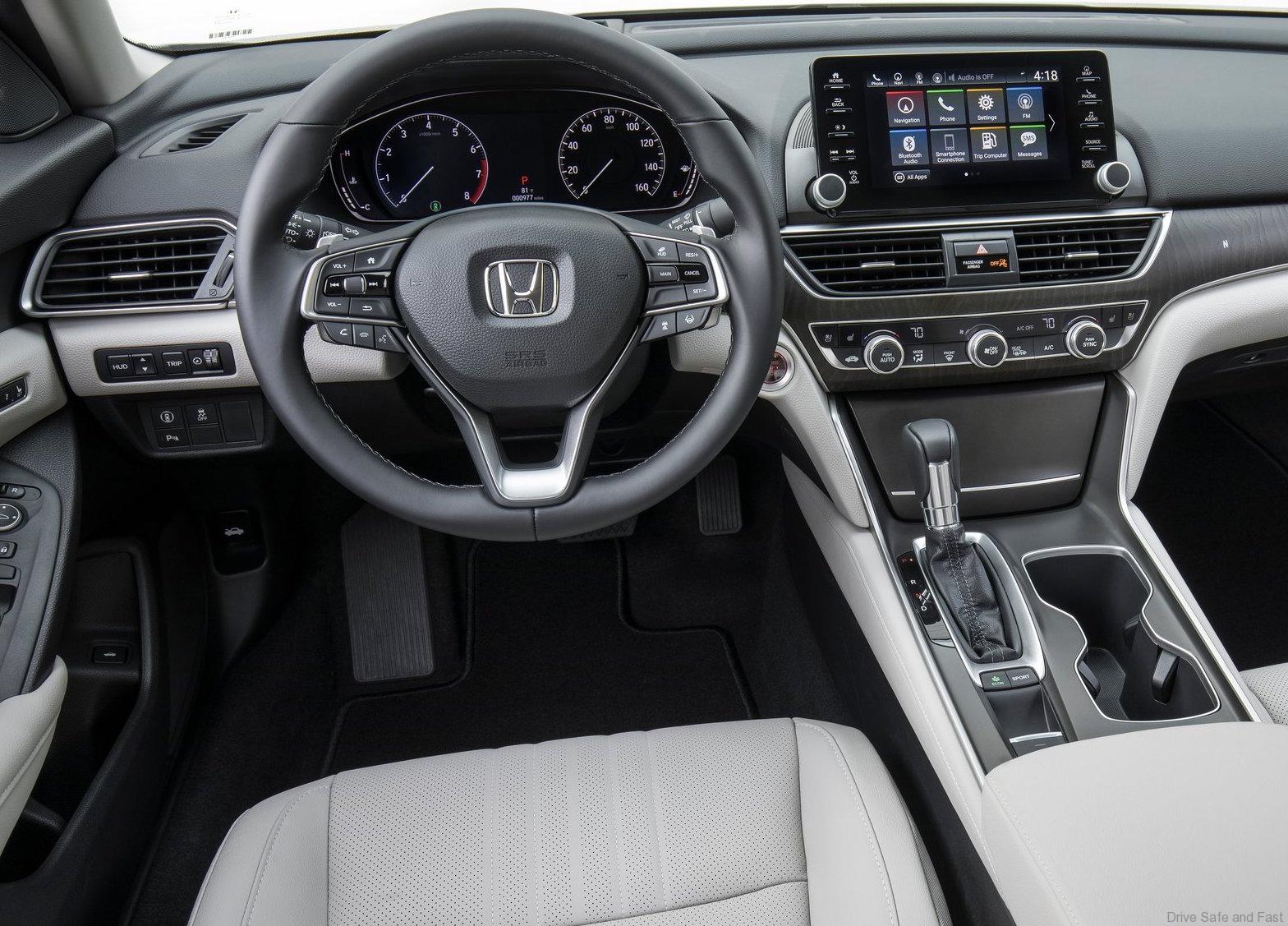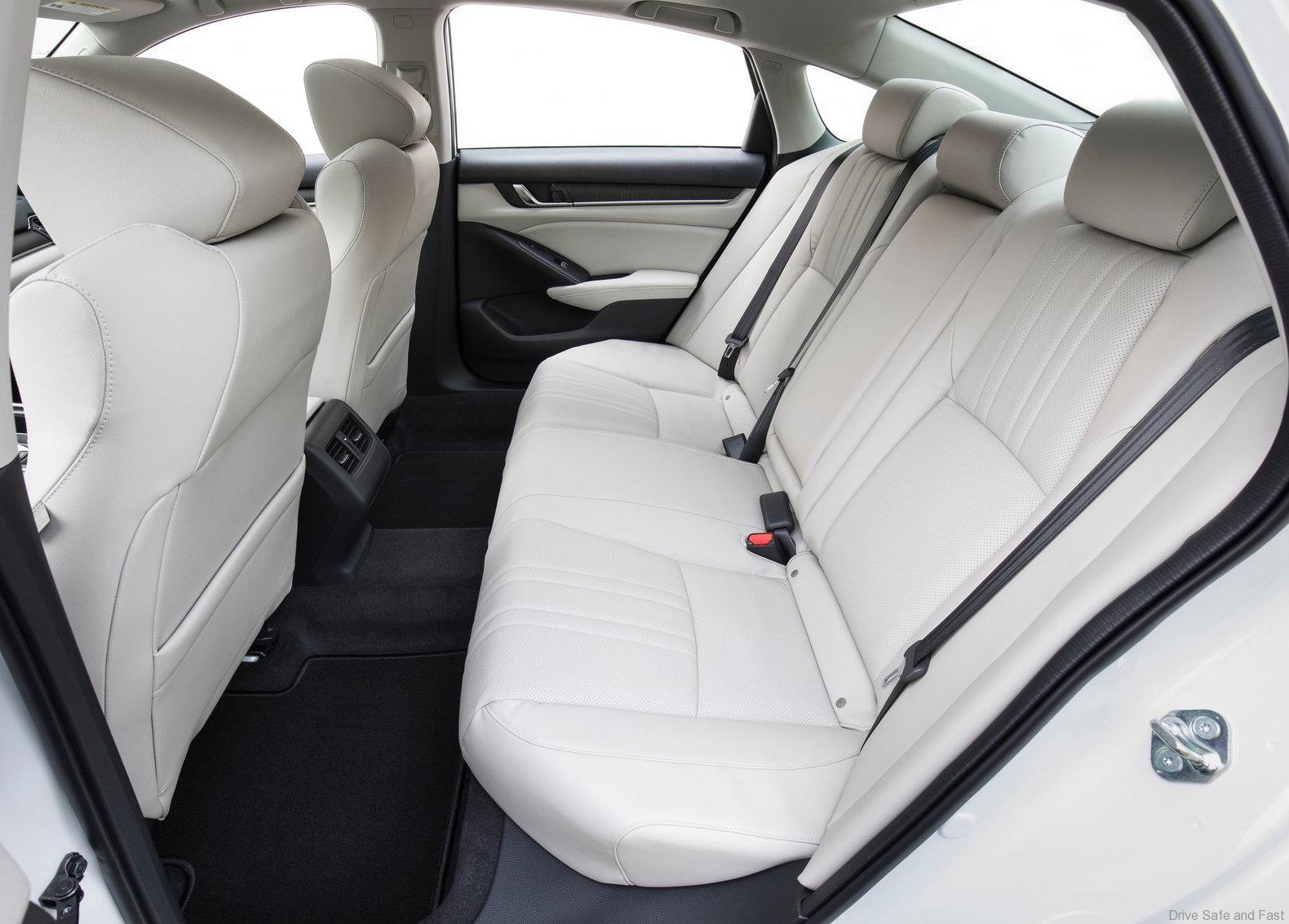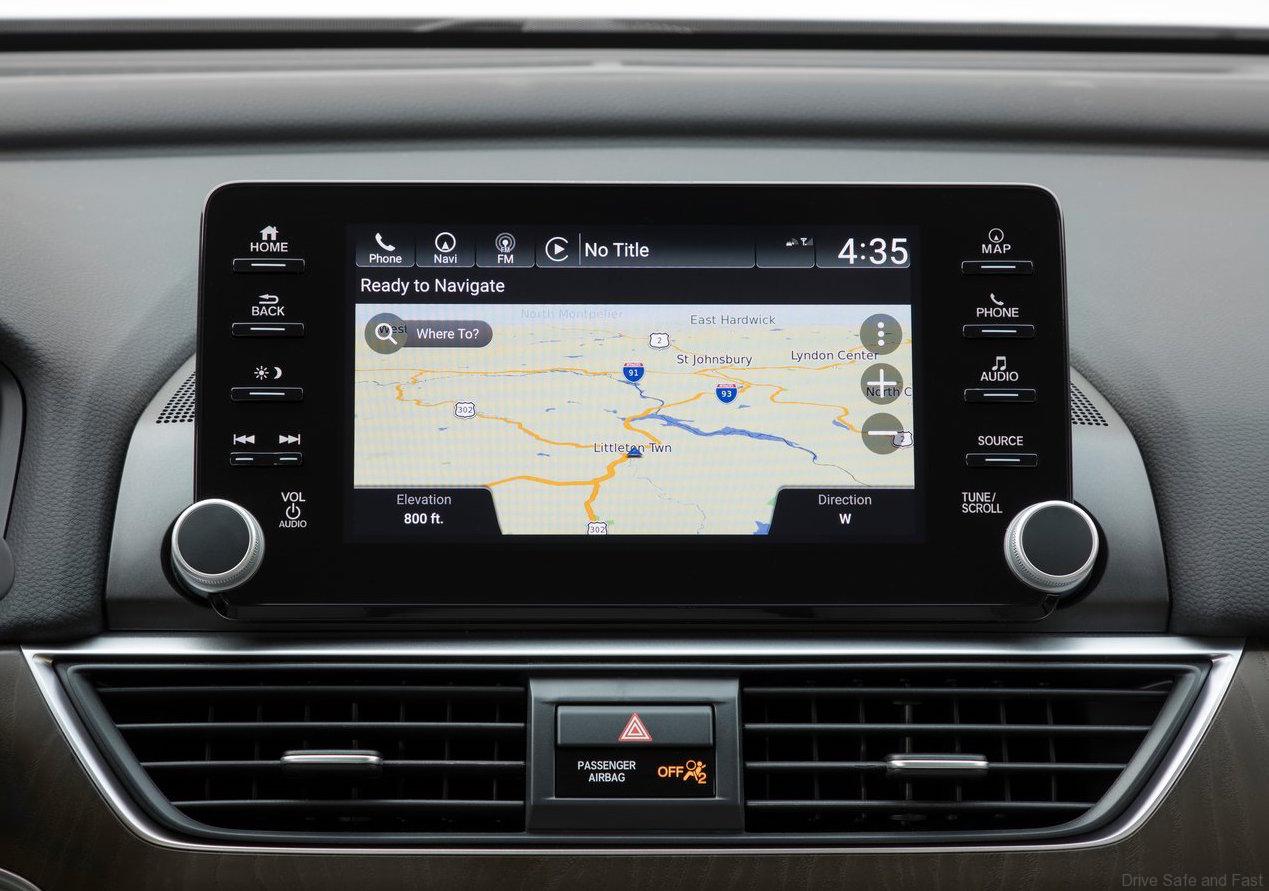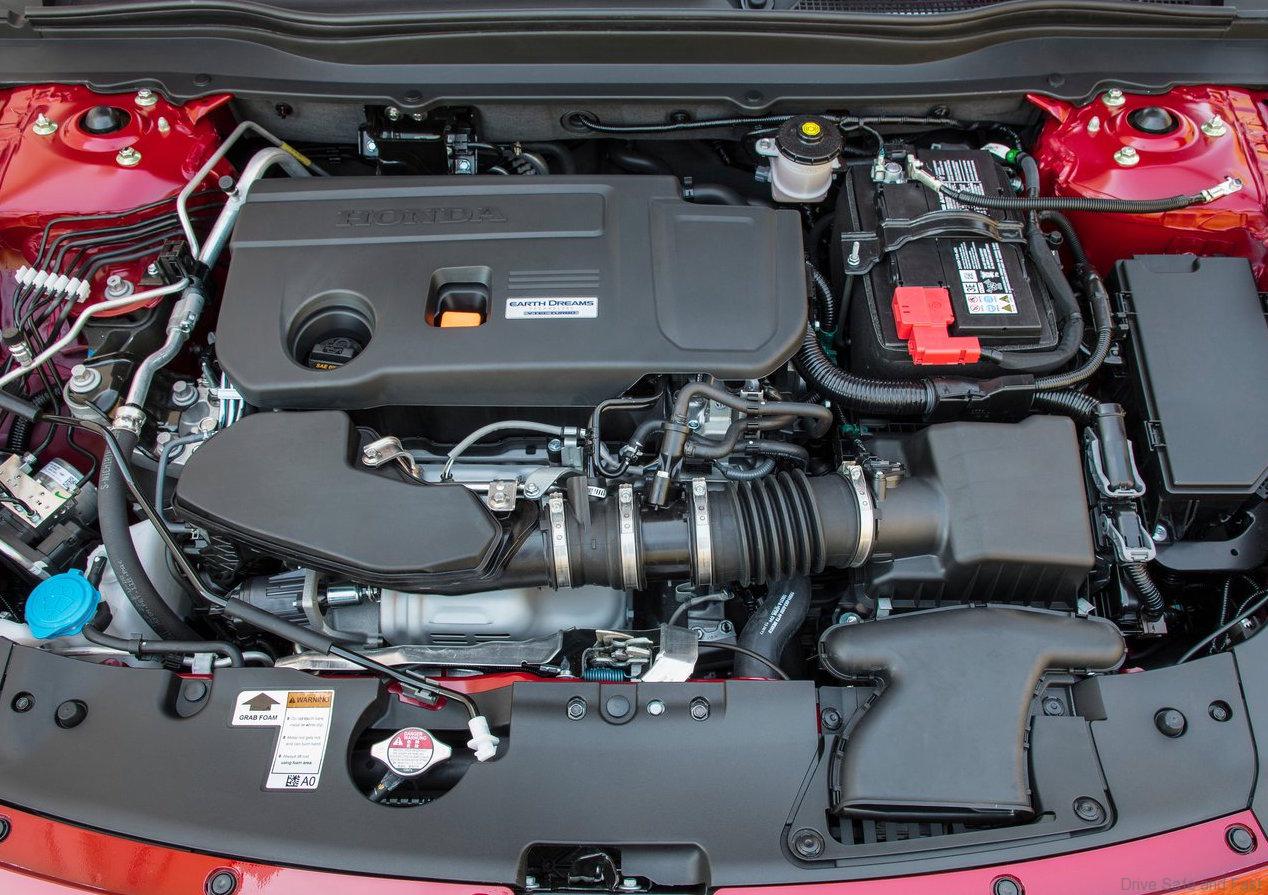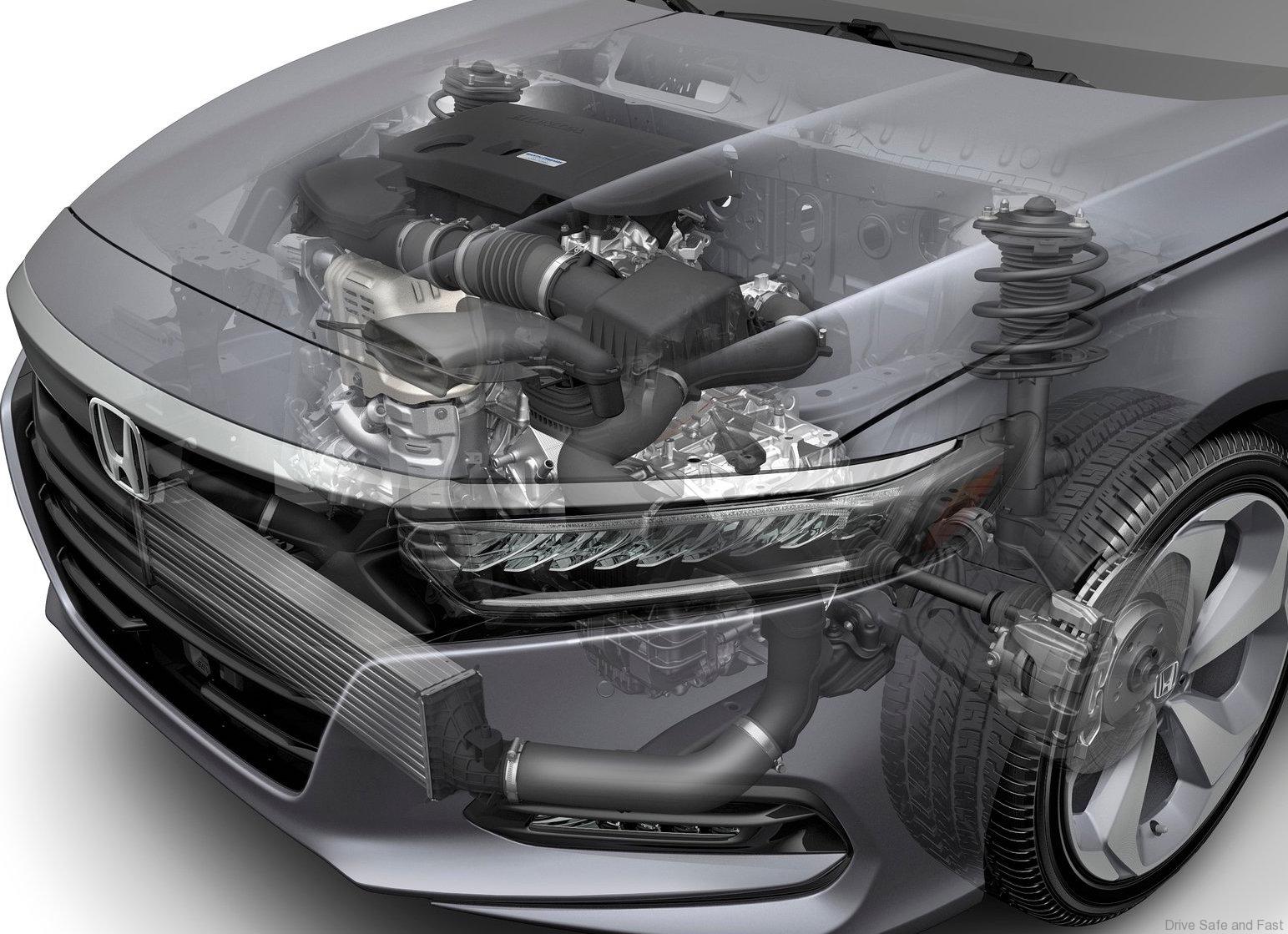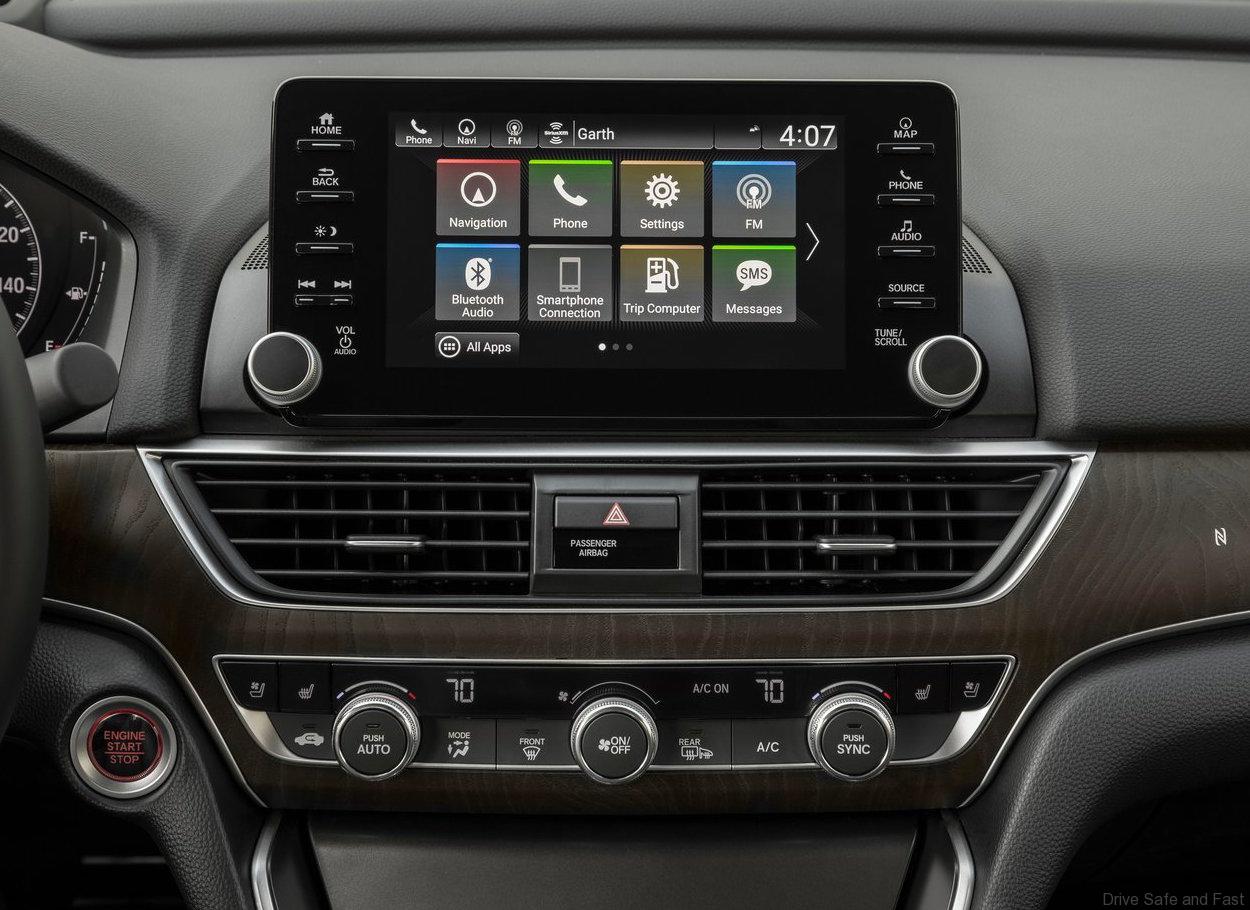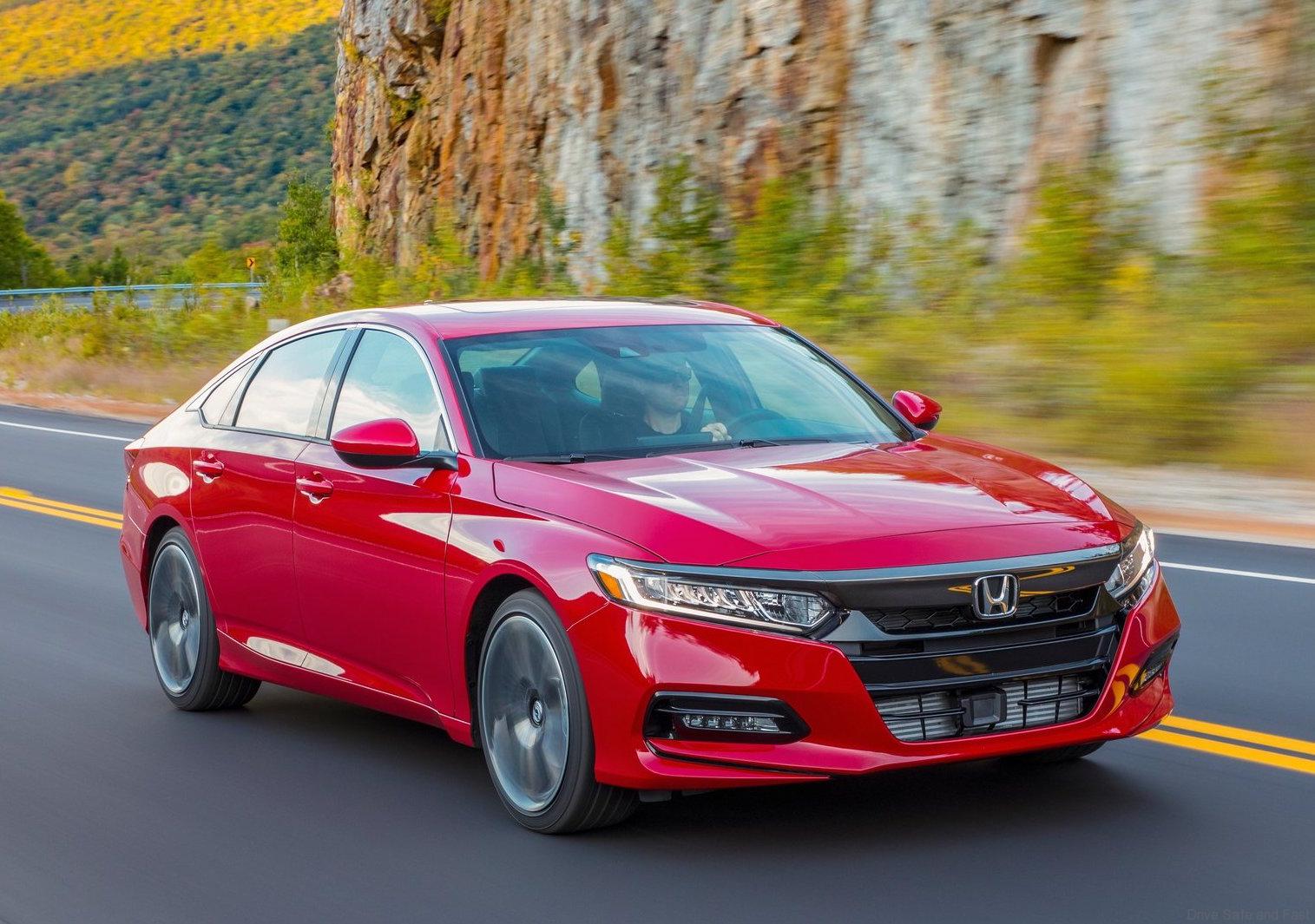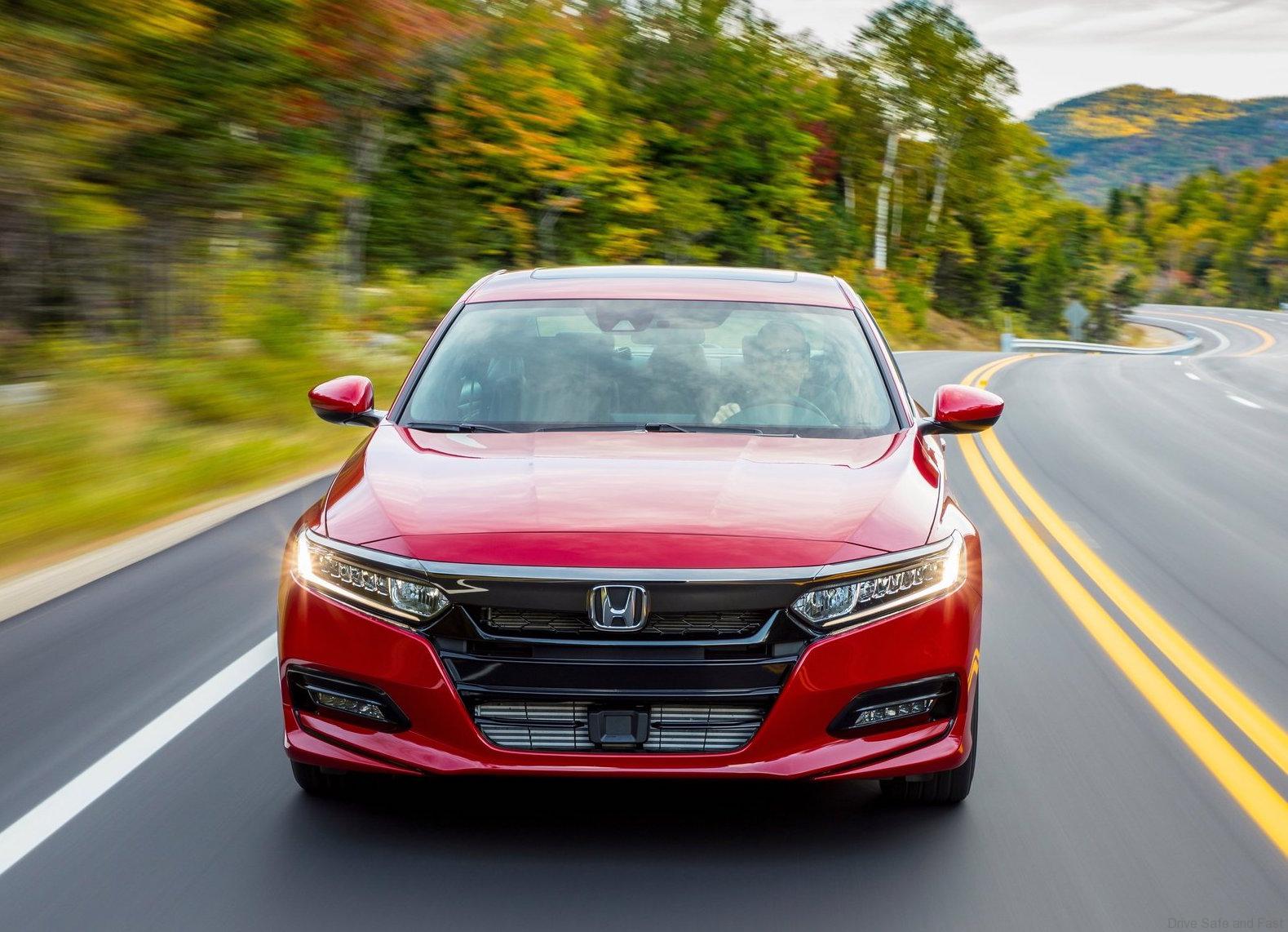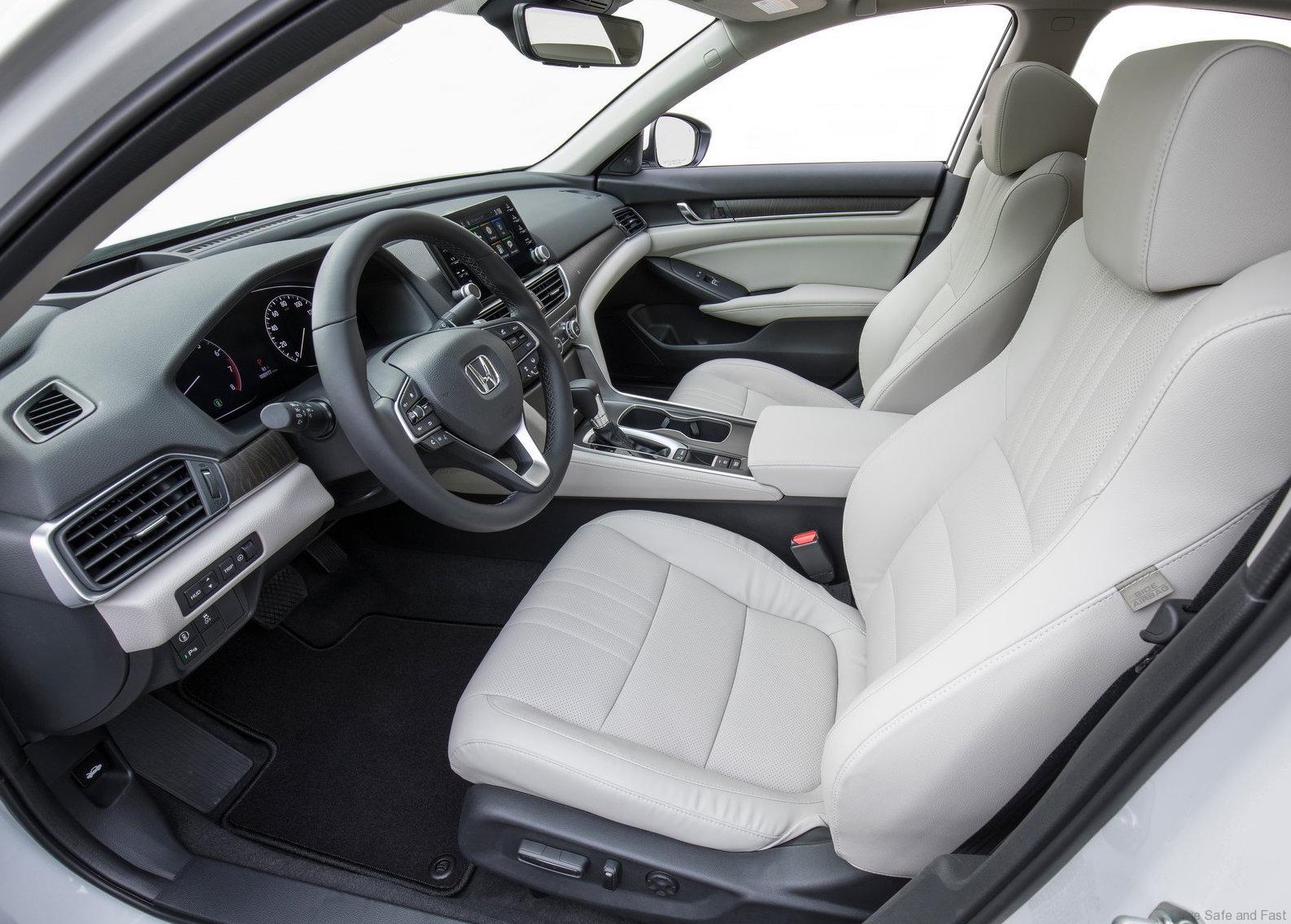In recreating Accord for its 10th generation, Honda designers and engineers sought to convey “absolute confidence” in every element of design and performance. Building on the bedrock character of Accord – its outstanding quality, fuel efficiency, packaging and sophisticated driving dynamics – they have imbued the 10th-generation Accord with a new level of emotional appeal and premium quality; an Accord that defies its mainstream midsize sedan status, providing even more refined and engaging performance, a more spacious and upscale interior, and the latest generation of advanced Honda safety, connected-car and driver-assistive technologies.
In summary, the most dramatically styled, premium and fun-to-drive Honda Accord yet.
Packaging and Design
In reimagining Accord, designers first established the fundamental packaging strategy. Consistent with the “Man Maximum-Machine Minimum (MM)” design philosophy that underpins all Honda designs, the team shrunk the Accord’s footprint while expanding its interior space, at the same time creating more premium and athletic proportions and stance. The move to 4-cylinder engines across the lineup is a key component of this approach, allowing a shorter engine bay while also reducing weight and improving dynamic performance.
The new Accord has a longer wheelbase (+2.16 inches), a lower overall height (-0.59 in.) and wider body (+0.39 in.), wider wheel tracks (+0.20 in. front, +0.79 in. rear), a shortened overall length (-0.39 in.) and a lower, sportier seating position (-1.0 in. front, -0.79 in. rear). A sweeping greenhouse, positioned farther back on the body, completes the new stance and proportion of the next-generation Honda Accord. The combined effect of these changes is a more premium look, highlighted by shorter overhangs, a bold front fascia, a long and low hood, and a visual center of gravity moved closer to the rear wheels.
Viewed head-on, the new Accord’s greenhouse also angles in more sharply from the window sills to the roof, further emphasizing the wide lower body, while inside the cabin the seats have been moved slightly inward, which contributes to improved hip, shoulder and head room while enhancing occupants’ freedom of movement. Also, the longer wheelbase allowed designers to move the second-row seats substantially rearward, giving Accord 1.9 inches of added rear legroom. Overall passenger volume is increased by 2.5 cubic feet (LX trim) and trunk space, at 16.7 cubic feet on all models and trims, is up 0.9 cubic feet on 1.5-liter and 2.0-liter models and 3.2 cubic feet on the Accord Hybrid, aided by the repackaging of the hybrid battery pack beneath the rear seats.
Elegant and modern exterior detailing compliments the Accord’s new, more dynamic design. The bold and upright front fascia is highlighted by Honda’s signature chrome wing front grille positioned above a large main air intake and flanked by available 9-lamp full-LED headlights and LED fog lights. The chiseled hood features a distinctive and aggressive raised center, and the deeply sculpted body sides enhance the visual length and strength of the lower body.
A new laser brazing process that joins the roof to the body side panels creates a clean exterior appearance with no need for a garnish over the rain channels. The similarly low and wide rear view is finished off with an upswept decklid, distinctive LED light-pipe taillights and available integrated dual exhaust ports. Overall aerodynamic efficiency is improved by approximately 3 percent (based on EX trim) to make it the most streamlined Honda Accord yet.
Elegant and Tech Savvy Cabin
The 2018 Accord also boasts a larger, more premium and tech savvy interior that compliments its athletic and elegant body design, delivering a level of quality and premium feel that belies Accord’s mainstream sedan status.
The new Accord features a panoramic forward view that is enabled by its lower cowl and by front roof pillars that are 20 percent narrower and moved rearward on the lower (and relative to the driver’s seating position). The new soft-touch instrument panel features an ultra-thin profile and three-tier design with a strong upper deck that describes a continuous arc from its outboard section through the side doorsills, giving a sense of strength and visual continuity.
A more intricately contoured sport inspired steering wheel with deep-set thumb rests and available paddle shifters compliment the Accord’s more sophisticated and sporty performance capabilities. Meticulous attention to the tactile and visual quality of surface materials and decorations communicates modernity and soft-spoken elegance throughout the cabin.
The inboard positioning of the seats provides for improved freedom of movement and is complimented by longer, wider and more deeply padded arm rests, front and rear; while the Accord’s newly designed seats feature taller shoulder bolstering for a more premium appearance and improved lateral support. New high-accuracy seat padding with variable firmness improves seating comfort and support. The driver’s seat now has available 12-way power adjustment with height-adjustable lumbar support, and passenger comfort is further enhanced by available new heated and ventilated front seats and by improved rear seat heating with both seat bottom and seat back heating elements.
The tech-savvy and easy-to-use 2018 Honda Accord cabin also features an all-new HMI that includes a7-inch TFT digital driver’s meter and an available new 8-inch Display Audio touchscreen interface with physical volume and tuning knobs. More intuitive, smartphone-like features and functionality including customizable app tiles and home-screen shortcuts, along with available Apple CarPlay™ and Android Auto™ compatibility and Wi-Fi-enabled over-the-air system updates, further enhance the new Accord.
The Accord also offers the next-generation of HondaLink telematics with new capabilities including emergency roadside assistance, remote locking/unlocking and engine start, stolen vehicle tracking, remote diagnostics, geofencing, speed tracking and more. Touring trims also feature a new 6-inch driver’s head-up display, wireless device charging, 4G LTE in-car Wi-Fi, and fast, automatic Bluetooth® phone pairing with Near Field Communication technology.
Turbocharged and Electrified Powertrains
The 2018 Accord takes an entirely new approach to performance by featuring three advanced new powerplants – two turbocharged 4-cylinder engines and the third generation of Honda’s two-motor hybrid powertrain technology. A new Honda-developed 10-speed automatic transmission (10AT), the first of its kind for a front-wheel-drive car, is paired with the new 2.0-liter engine, and a short-throw 6-speed manual transmission is available for both turbocharged engines in Sport trim.
The new 1.5-liter, 16-valve DOHC direct-injected turbo with dual Variable Timing Control (dual VTC) and VTEC produces a peak of 192 horsepower (SAE net) at 5,500 rpm and 192 lb.-ft. of torque (SAE net) from 1,600 to 5,000 rpm, up from 185 HP (SAE net) at 6,400 rpm and 181 lb.-ft. (SAE net) at 3,900 rpm on the existing normally-aspirated 2.4-liter model. The new 1.5-liter turbo is mated to a Honda continuously variable automatic transmission (CVT), or in Sport trim to a CVT or a 6-speed manual transmission (6MT).
The Accord can also be equipped with a new 2.0-liter 16-valve DOHC direct-injected turbo with VTEC® valvetrain and dual VTC, paired with a 10-speed automatic transmission or, in Sport trim, to the 10AT or an available 6-speed manual. The new 2.0-liter turbo, sharing much of its design with the 2017 Civic Type R, produces 252 HP (SAE net) at 6,500 rpm and 273 lb.-ft. of torque (SAE Net) from 1,500 to 4,000 rpm, compared to 278 HP (SAE net) at 6,200 rpm and 252 lb.-ft. (SAE net) at 4,900 rpm for the 3.5-liter V6 that it replaces.
The new Accord Hybrid is powered by the 3rd-generation of Honda’s two-motor hybrid technology featuring a 2.0-liter 16-valve DOHC Atkinson cycle engine with greater than 40 percent thermal efficiency, the highest for any mass-produced Honda engine, paired with two electric motors. As before, the Honda Accord two-motor system operates without the need for a conventional automatic transmission. Additionally, a new, more compact intelligent power unit (IPU), containing the hybrid battery pack and its control systems, is now mounted under the rear floor instead of in the trunk, preserving both cargo space (16.7 cu.-ft.) and the flexibility of a 60/40-split and folding rear seat, standard on all Hybrid models and trims.
Body and Chassis Design
The 2018 Accord’s new body structure is lighter and more rigid, utilizing 29 percent ultra-high-strength steel, the most ever for a mass-produced Honda car. Overall, the new Accord employs 54.2 percent high strength steel (above 440 MPa).
Key body features include the latest generation of Honda’s Advanced Compatibility Engineering™ (ACE™) body structure with crash stroke front frame, tailor-tempered rear frame members for improved crash-energy absorption, and the extensive use of structural adhesives for increased rigidity, cabin quietness and weight reduction. Total vehicle weight is down between approximately 110 to 176 pounds, depending on trim, while body torsional and bending rigidity are improved 32 and 24 percent, respectively, aiding ride quality, cabin quietness, and dynamic performance.
Mated to the new body is a more sophisticated new chassis design. The 2018 Accord’s chassis is 6-percent lighter than before (not including wheels and tires) and features a new Macpherson strut front suspension with L-shaped aluminum lower arms mounted to an aluminum front subframe. The new setup better isolates and manages varying road inputs, improving handling precision, ride quality and cabin quietness along with outstanding high-speed stability and control. The new, more space-efficient rear suspension is a multi-link design mounted to a more rigid, floating rear subframe. Fluid-filled compliance bushings at all four corners further improve ride comfort and absorption of road irregularities.
Touring trims of Accord also feature, for the first time, an Adaptive Damper System with the ability to adjust shock absorber damping force every 1/500 of a second (0.002 second), using a proprietary Honda control algorithm, providing for a more compliant and controlled ride in all driving situations. The adaptive dampers are tied to a Two-Mode Driving System with Normal and Sport modes that allows the driver to dial-up/down the vehicle’s sporty reflexes depending on the driving environment. The system engages with multiple chassis and drivetrain components, including the new dual-pinion variable-ratio electric power steering (EPS), automatic transmission, drive-by-wire throttle, adaptive dampers and Active Sound Control system, to provide the driver with an expanded range of driving characteristics. An ECON mode is also available that helps improve fuel efficiency by modifying throttle mapping and HVAC operation.
The new Accord has a 10-mm lower center of gravity. The adoption of lighter-weight turbocharged engines and other body design changes reduce the vehicle’s moment of inertia, resulting in crisper turn-in and steering response. All models now have near optimal FWD weight distribution of approximately 60/40 percent front/rear. Accords with the new 2.0-liter VTEC turbo and 10AT check in at approximately 61/39 percent front/rear, a significant improvement versus the current V6 Honda Accord with 6AT.
Along with the first application of structural adhesives to Accord, cabin quietness is further enhanced by a comprehensive sound-insulating package that includes full underbody covers (which also aid aerodynamics), front and rear fender and engine compartment insulators, alloy wheels with Honda-proprietary resonator technology, sound-absorbing carpet, acoustic laminated windshield glass – plus front door acoustic glass on EX and above – and a new, 3-microphone Active Noise Control system. The result is low noise levels with a well-balanced sound quality and a pleasingly sporty engine note.
Advanced Safety and Driver-Assistive Technology
For 2018, all Accords feature the full suite of Honda Sensing® safety and driver-assistive technologies as standard equipment. Honda Sensing includes Collision Mitigation Braking System™ (CMBS™), Lane Departure Warning, Road Departure Mitigation, Adaptive Cruise Control with Low-Speed Follow and, for the first time, Traffic Sign Recognition. Additional available driver-assistive technologies include Blind Spot Information, front and rear parking sensors, Rear Cross Traffic Monitor and Driver Awareness Monitor; and all models feature a Multi-Angle Rearview Camera with dynamic guidelines.
Standard advanced active and passive safety systems include Vehicle Stability Assist with Traction Control, Anti-lock brakes with Electronic Brake Booster, Tire Pressure Monitoring System (TPMS), advanced front airbags, driver and front-passenger side airbags and new driver and front-passenger knee airbags. The Accord targets top U.S. government (NCAP) and IIHS collision safety ratings.
Body and Exterior
In its evolution to becoming a more premium, sophisticated and aspirational sedan, the all-new 10th-generation Accord adopts a stronger, lighter and significantly more rigid body. Its lower and wider exterior proportions express a more premium and athletic stance, accentuated by a longer wheelbase and wider track, advanced LED exterior lighting (including available LED headlights and fog lights) and luxurious bright trim. Dramatic aerodynamic advancements and a choice of new 17- and 19-inch alloy wheels (five wheel designs in total), all contribute to a more confident, youthful and sporty sedan.
The next-generation Accord body uses over twice as much super high-strength steel (29 percent) as the previous-generation Accord Sedan – along with the model’s first use of structural adhesives – to increase global bending rigidity by 24 percent, torsional rigidity by 32 percent and floor bending rigidity by 12 percent, which in turn improves all aspects of the vehicle’s dynamic performance. Widespread noise, vibration and harshness (NVH) countermeasures, including the flagship sedan’s first use of acoustic spray foam insulation and airflow management technology such as the Active Shutter Grille System, make the 2018 Accord the quietest, most comfortable and efficient Honda Accord yet.
Exterior Styling
Upscale and sophisticated, confident and distinctive, youthful and sporty – the 10th generation Accord design strongly advances the emotional and aspirational appeal of Accord. Designed to distinguish itself as a “class above” its competitors, the new Accord has a wider stance, lower roofline and a dramatically longer, lower hood to achieve improved dynamics, a more comfortable interior and a more dramatic presence. Using a slightly shorter overhang than before, the front-end design is characteristically Honda, with the chrome wing grille and streamlined wing-shaped headlights (LED high/low beams on the Touring trim), and aggressive air inlets presenting a strong image. Aggressive hood lines add an athletic look to the Accord front end, while thinner A-pillars moved rearward on the body (and relative to the driver’s seating position) improve outward visibility for the driver by 7.9 degrees compared to the previous Accord Sedan.
The sporty body sides are distinguished by strong wheel arches, an emphatic character line running from front to rear along the beltline, concave door panels that capture the light just right, and strong, flowing lower sills – finished with bright trim on the Touring trim – that lend a look of solidity at the base of the body.
With the new Accord’s longer wheelbase, the more spacious cabin is even more streamlined than before, with a more tapered rear section including longer and sleeker quarter windows. These windows contribute to a large “6-light glass” cabin that adds lightness, visibility and a sporty flair to the new Honda Accord, while a bright trim strip flowing front to rear above the windows adds a windswept look.
In back, the brightly trimmed rear fascia is as athletic and energetically designed as the front end, with a slightly longer overhang than found on the previous generation Accord. Here, a sharply tailored decklid helps air separate cleanly from the body, while bright trim (including dual bright exhaust finishers on the Touring trim) add an upscale look, and dramatic light-pipe LED taillights define the Accord as all new – and all Honda.
LED Lighting
All Accord trims incorporate a wide range of light-emitting diode (LED) exterior lighting features, including standard LED daytime running lights (DRL), an array of six LED low-beam headlights, LED one-touch turn signals (including mirror-mounted LED turn signals on the EX-L and Touring trims), and LED taillights, brake lights, license-plate light and center high-mounted stop light.
LED lighting has several advantages beside improved visibility. The LEDs are both mercury free and lead free, minimizing environmental impact. They also require less power to operate than traditional incandescent lighting, which helps fuel efficiency. The versatility of the LED arrays also contributes to the Accord’s dramatic design. Finally, LED lights have a longer life and are maintenance free.
LED Taillights
The C-shaped design of the LED taillights complements the design of the front LED DRLs and contribute to a distinct Honda Accord appearance that is easy to spot on the road. The taillight shape also mimics the trapezoidal shape of the Touring trim’s bright dual exhaust finishers. The Accord Hybrid is also distinguished by blue-tinted lenses over the backup lights.
Exterior Dimensions
The 2018 Accord has a 111.4-in wheelbase, 2.1-in. longer than the previous generation, to provide excellent ride comfort, outstanding second-row seating roominess (including nearly two inches of additional rear-seat legroom), and easy ingress and egress. The slightly shorter front body overhang and the slightly longer rear body overhang combine to incrementally reduce the new Accord’s overall length by 0.4 inches to 192.1 inches total vs. the 2017 model.
A 0.6-in lower overall height and 0.5-in greater width combine to give the new Accord a more aggressive visual appearance.
Cargo Area
The 2018 Accord offers 16.7 cu. ft. of storage (+0.9 cu. ft.), the largest in class. This measurement also applies to the new Accord Hybrid, which gains 3.2 cu. ft. compared to the last generation model.
Advanced Compatibility Engineering™ (ACE™) Body Structure
As an integral part of the 2018 Accord structure, Honda’s proprietary Advanced Compatibility Engineering™ (ACE™) body structure enhances occupant protection and crash compatibility in frontal collisions. ACE utilizes a network of connected structural elements to distribute crash energy more evenly throughout the front of the vehicle, thus reducing the forces transferred to the passenger compartment. ACE channels frontal crash energy to both upper and lower structural elements, including the floor frame rails, side sills and A-pillars.
Crash Stroke
The ACE™ structure features crash stroke technology, developed by Honda. In a frontal collision, a link structure in the front subframe area under the engine helps absorb and dissipate crash energy progressively to minimize potential powertrain intrusion to the cabin structure.
Aerodynamic Efficiency
The 2018 Honda Accord was designed to have class-leading aerodynamic performance, with a significantly lower drag coefficient – approximately 3 percent – than the previous Accord. Detailed management of exterior, underbody and engine room airflow, along with specific wheel designs, all contribute to aerodynamic drag reduction, helping to improve both fuel efficiency and interior quietness. Computational fluid dynamics (CFD) was used to evaluate the car’s efficiency during the design phase, followed by scale-model wind tunnel testing and finally by full-scale testing at the Sakura Wind Tunnel.
Specially shaped components at the front of the vehicle guide airflow through the radiator and into the engine’s cold-air intake, while smoothly channeling the remaining airflow efficiently over, around and under the vehicle. Body details include sculpted “air curtains” located at outside corners of front fascia, 20-percent narrower A-pillars and wide, flush-mounted windshield glass, all of which contribute to the Accord’s efficient passage through the air.
Underbody Aero Package
The new Accord includes the most extensive use of underbody aerodynamic aids in model history. The aero package consists of a broad undercover that extends rearward from below the front fascia to cover the engine and transmission, flat underbody surfaces spanning much of the area between the front and rear wheel areas, and air-diverting strakes positioned ahead of the front tires that help deflect airflow for additional efficiency gains. An additional undercover is located underneath the fuel tank. Even the exhaust silencers are aerodynamically shaped, eliminating the need for under covers at the rear of the vehicle.
Active Shutter Grille System
In a first for Accord, Honda’s Active Shutter Grille system reduces aerodynamic drag at cruising speeds, helping improve fuel efficiency. It is included on 1.5-liter EX and EX-L trims. The system uses an electric actuator controlled by a processor that tracks major temperature parameters, including engine coolant and radiator temperatures, intake air temperature, transmission oil temperature and air-conditioning requirements, all of which can vary due to weather, road conditions, vehicle speed, throttle and gear positions. Located behind the upper grille opening, the four shutters open or close simultaneously to control the amount of air flowing through the engine’s radiator and the air conditioner’s condenser. The system is designed to keep the shutters closed as much as possible in order to minimize aerodynamic drag – even in city driving. Located inside the upper grille opening only, the active shutters do not control airflow to the intercooler.
Exterior Colors
The 2018 Accord is available in 11 exterior colors including six pearlescent colors, four metallic colors and one solid color. New to Honda and the Accord are Platinum White Pearl and Radiant Red Metallic.
The Platinum White Pearl color uses large-particle glass flakes for enhanced brilliance compared to traditional white pearl finishes, while in the Radiant Red Metallic color, glittering metallic particles radiate light in a distinctive fashion.
Powertrain
The 10th generation 2018 Accord takes an entirely new approach to performance with its two new direct-injected VTEC Turbo® 4-cylinder engines with dual VTC – a 1.5-liter 16-valve inline-4 and a 2.0-liter 16-valve DOHC inline-4. Both new turbocharged engines produce peak torque across a broad range of engine speed (RPM), delivering smooth and virtually lag-free power for exceptional throttle response and power delivery in all driving conditions.
The 1.5-liter turbo is mated to a Honda continuously variable automatic transmission (CVT) with G-Shift Control or, in Sport trim, to either a CVT or a short-throw 6-speed manual transmission (6MT). The new 2.0-liter turbo, sharing much of its design with the 2017 Civic Type-R engine, can be mated to a smooth, responsive Honda-designed 10-speed automatic, the first of its kind for a front-wheel-drive car, or, in Sport trim, to the 10AT or a short-throw 6-speed manual.
The two new automatic transmissions take greater advantage of available torque while maximizing quietness and efficiency during highway cruising. The redesigned CVT has an 11-percent lower ratio compared to the previous generation version for more powerful launch performance, while the new 10AT is 22 lbs. lighter, with a 43-percent lower first gear and a 17-percent taller top gear compared to the previous generation Honda Accord’s 6-speed automatic.
The new gas-engine powertrains are joined by the third generation of Honda’s Intelligent Multi-Mode Drive (iMMD) two-motor hybrid technology. The new hybrid powertrain features a 2.0-liter Atkinson-cycle engine with improved thermal efficiently, now at 40 percent (up from 38.9 percent on the 2017 Accord Hybrid), the highest for any mass-produced Honda engine. The engine is paired with two Honda-developed electric motors that are the first drive motors in the world to use permanent magnets containing no heavy rare-earth metals. As before, the Accord two-motor system operates without the need for a conventional automatic transmission.
Additionally, a new, more compact intelligent power unit (IPU) containing the hybrid battery pack and its control systems is now mounted under the rear floor instead of in the trunk. This packaging provides the same 16.7 cu. ft. of trunk space as its gasoline-only counterpart, and preserves the flexibility and utility of a 60/40-split and folding rear seat, standard on the Accord Hybrid EX and above trims.
Turbocharged 1.5-Liter In-Line 4 Cylinder
The new DOHC 1.5-liter engine in the Accord is a further evolution of the powerplant first introduced in the 2016 Civic and later applied to the 2017 CR-V. With direct injection, a low-inertia Mono scroll turbo with electric waste-gate and dual Variable Timing Control (VTC), the turbocharged powerplant delivers more horsepower and torque than before.
Power output is increased in part by a new “4-into-2” exhaust manifold that improves the flow of exhaust gas to the turbo. Peak output of 192 horsepower (hp) at 5,500 rpm and 192 lb.-ft. of torque from 1,600 to 5,000, compared to 185 hp at 6,400 rpm and 181 lb.-ft. at 3,900 rpm on the previous Accord’s normally aspirated 2.4-liter engine.
The Accord 1.5-liter turbo is rated by the EPA at 30/38/33 mpg when equipped with the available CVT transmission (except Sport trim), and 26/35/30 mpg city/highway/combined when equipped with the standard 6-speed manual transmission, improvements of up to 3/2/3 mpg for the CVT, and 3/3/4 mpg for the 6MT, depending on trim.
Cylinder Head and Valvetrain
The direct-injected 1.5-liter 4-cylinder turbocharged engine has a lightweight, low-pressure die-cast aluminum alloy cylinder head with exhaust manifold cast directly into the cylinder head, eliminating the need for a separate exhaust manifold. For improved fuel efficiency and responsiveness, the manifold has a “4-into-2” design; the engine’s eight exhaust valves are grouped in two sets of four, each group with a separate exhaust manifold and exit port to the turbocharger cast into the cylinder head, which helps smooth exhaust flow to the turbocharger for more efficient operation and better low-rpm response.
A low-friction, silent-chain drives dual overhead cams and four valves per cylinder. The cam drive is maintenance free throughout the life of the engine. To help further reduce weight, new thin-wall hollow camshafts are used.
To benefit fuel efficiency, emissions and power, the turbo engine utilizes sodium filled exhaust valves. A hollow chamber within the valve contains sodium that is cooled by the exhaust port cooling jacket. Since the chamber reaches close to the valve head, the sodium helps to cool the entire valve. Since the valve is internally cooled, it doesn’t need the enriched fuel mixture that was generally used in turbo engines to help cool the exhaust valve. The resultant leaner mixture reduces emissions, increases fuel efficiency and helps increase power.
The cylinder head includes small 12-millimeter (M12) sparkplugs, down from the more common 14-millimeter (M14) size, to save space and weight. The head also includes direct-injection multi-hole fuel injectors with a small diameter bore. Higher-pressure direct injection optimizes fuel atomization, allowing for more efficient combustion. To provide a high-tumble intake charge that further enhances combustion efficiency, both the intake port and piston crown have special designs.
The 1.5-liter DOHC 16-valve VTEC Turbo engine uses an advanced valve control system to combine high power output with high fuel efficiency and low emissions. The system combines intake and exhaust Variable Timing Control (dual VTC), which continuously adjusts the intake and exhaust camshaft phase, with Variable Valve Timing and Lift Electronic Control (VTEC), which changes valve lift, timing and duration of the exhaust valves. In this application, the increased valve lift from VTEC operation varies to improve gas scavenging at low speed, part throttle conditions, as well as higher speed, full throttle operation, helping to improve performance across the engine speed range.
The cam timing is varied based on input from sensors that monitor rpm, timing, throttle opening, cam position and exhaust air-fuel ratio. The result is increased fuel efficiency and lower emissions.
Turbocharged 2.0-Liter In-Line 4 Cylinder
Assembled in Honda’s Anna, Ohio engine plant using domestic and globally-sourced parts, the Honda Accord’s available DOHC 2.0-liter engine shares much of its design with the race-bred 2017 Civic Type R and has the highest torque ever offered in an Accord. Compared to the 2.0-liter turbo in the Civic Type R, the Accord’s 2.0-liter engine uses a turbocharger with a smaller, low-inertia turbine for improved low-rpm boost response. With a maximum of 20.8 psi of boost, the Accord’s 2.0-liter powerplant peak output is 252 hp (SAE net) at 6,500 rpm and 273 lb.-ft. of torque (SAE net) from 1,500 to 4,000 rpm.
With 33-percent greater displacement than the Accord’s standard 1.5-liter turbocharged engine, the 2.0-liter powerplant delivers a maximum increase of 60 horsepower and 81 lb.-ft. of torque. Compared to the 3.5-liter normally aspirated V6 it replaces, the 2.0-liter engine has less peak horsepower (252 vs. 278) but greater peak torque (273 lb.-ft. of torque from 1,500 to 4,000 rpm, vs. 252 lb.-ft. at 4,900 rpm). With peak torque available at a much lower engine rpm, responsiveness and acceleration are notably enhanced. The 2.0-liter turbo also offers much broader power delivery, holding a torque advantage over the V6 that spans the entire operating range between 1200 and 4800 rpm – the engine rpm range that is typically used the most.
The turbocharged Accord 2.0-liter turbo is designed to operate on Regular unleaded fuel. EPA fuel economy ratings are pending at this writing.

